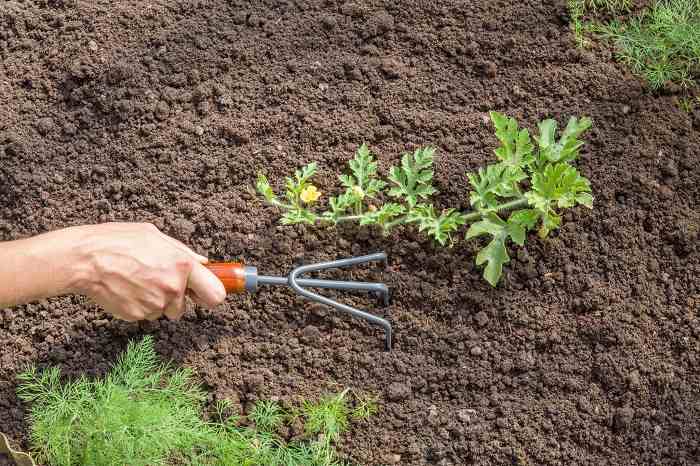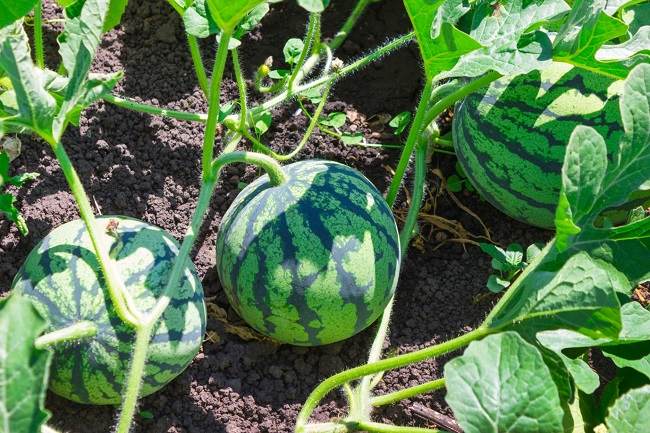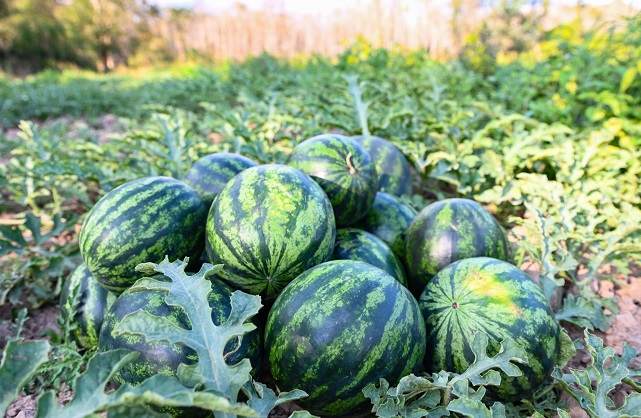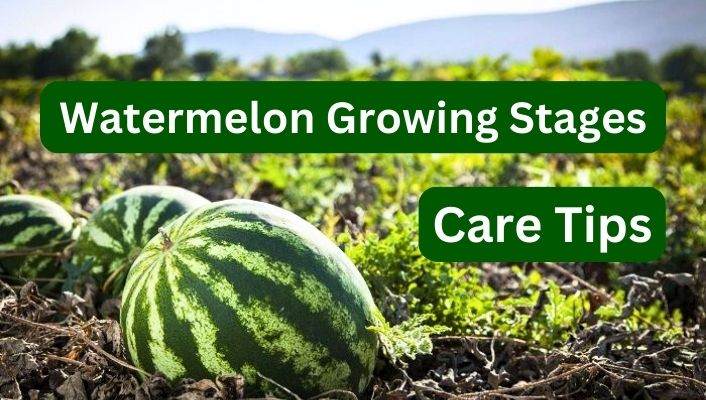Growing watermelons is not difficult, but much depends on the climate and weather conditions. One thing that really helps meet this plant’s needs is getting used to the watermelon growth stages.
This article details the watermelon growing stages so you know how to care for each stage.
Also includes a care guide for growing watermelons and common problems you may encounter when doing so. Best to be prepared for anything!
Let’s get started!
Post Contents
Watermelon Basic Information:
The following table provides essential information about the Watermelon plant. Explore the details to gain valuable insights into growing and cultivating this delicious fruit.
| Information | Description |
|---|---|
| Scientific Name | Citrullus lanatus |
| Family | Cucurbitaceae |
| Origin | Africa |
| Lifespan | Annual |
| Plant Type | Vine |
| Sunlight Requirements | Full sun |
| Soil Type | Well-drained, fertile soil |
| Watering Needs | Regular watering, keep soil moist |
| Germination Time | 7-10 days |
| Flowering Time | 35-55 days |
| Harvest Time | 70-90 days after planting |
| Fruit Size | Varies (typically 10-50 pounds) |
| Fruit Flavor | Sweet and juicy |
| Pollination | Mostly insect-pollinated |
| Common Pests | Aphids, spider mites, cucumber beetles |
| Common Diseases | Powdery mildew, fusarium wilt |
The 9 Watermelon Growing Stages:
Watermelon has nine stages of his growth, each of which is detailed in this section.
It is important to understand these stages as they are critical to the proper management of this fruit. For example, you don’t need the same amount of water immediately after planting and just before harvesting.

Zucchini, cucumber, cantaloupe and squash also belong to the same family as watermelon and are collectively known as Cucurbitaceae. For example, knowing about pumpkin growth stages may help you master watermelon growth stages faster.
1. Planting Stage:
The first phase is planting. Before you start, you need to decide which variety of watermelon to choose. If you live in a colder climate, it is advisable to choose an early-maturing variety, as watermelons have a long growing season and need as much sunshine as possible.
If so, you don’t need to plant watermelon seeds in the spring because you have more options and more warm days.
If you live in a cold climate, start sowing watermelon seeds indoors about four weeks before the last frost date and transplant when the soil temperature reaches at least 21°C.

You should also consider hoeing the seeds to encourage rooting before planting. Simply place the watermelon seeds on a damp paper towel, place them in a container, and cover with plastic wrap.
Seeds will root in 2-3 days. This allows you to plant only viable seeds, saving effort and ensuring higher yields.
Plant seeds 1 inch deep and about 6 feet apart. This will give the seed the space it needs to grow and spread. Or use a trellis and plant vertically.
Finally, ensure that the growing medium is loamy, well-drained, and that the site you have chosen for the watermelon receives 8-12 hours of sunlight. Water the seeds thoroughly.
Also Read: 5 Bell Pepper Growing Stages! [An Ultimate Guide]
2. Germination Stage:
Second stage is the germination of the seed. But if you plant watermelon seeds in a medium below 18°C, they will not germinate, so be careful.
In addition, water is essential for germination, and without water, roots cannot emerge from the seed coat. We’ve already talked about initiating the germination process on a damp cloth, but this process isn’t all that different. Start
3. Sprouting Stage:
It takes 3 to 12 days for the seed to fully germinate, and you’ll see small green shoots known as germ layers sticking out of the ground.
These young watermelon seedlings are vulnerable and should be protected from wind and animals if grown outdoors. Don’t forget to water them and keep the soil moist.
If you start sowing indoors, wait until the leaves have grown and the vine is 15-25 cm.
4. Vegetative Growth Stage:
As the seeds germinate and germinate, you will find that the plants grow faster and faster. The first set of true leaves appear within 5-10 days and are distinct from the germ layers.

These first true leaves initiate photosynthesis and provide the food and energy the plant needs to grow. Within two weeks you will notice rapid growth, which will lengthen and become more prominent over time.
The vine usually grows to about 12 feet in length and you will notice new vines a month after planting.
5. Branching Stage:
Branching is the appearance of new vines that do not necessarily need to be removed. However, you need to give your watermelon extra nutrients, and adding 1/2 cup (120 mL) of bonemeal to the soil may be enough.
Gently mix the bonemeal into the soil, being careful not to damage the root system. Watermelons grow quickly during this period, so increase the number of waterings. It is enough to give 2.5 cm of water twice a week.
Vines and leaves continue to grow until the plant begins to flower.
6. Flower Production and Pollination Stage:
You may have heard of male and female watermelons, but it’s a myth. In fact, watermelons have male and female flowers, and produce unisex fruit.
Male flowers appear first, followed soon after by female flowers and pollination begins. Male flowers contain pollen, which is carried to female ovules, which, if pollinated successfully, produce fruit.
Bees, bumblebees and wasps help with pollination and do the hard work. However, if you want to avoid cross-pollination, hand-pollination is the way to go. It is necessary to separate the watermelon from other flowering plants and use cotton swabs to transfer the pollen from male to female flowers.
7. Fruit Setting Stage:
First, a small bulge can be seen behind the female watermelon flower. This slowly swells and grows to form the fruit we know as watermelon.
Once the fruit begins to develop, the plants can be fertilized with a low nitrogen fertilizer. At this stage, you don’t want the fruit to taste watery, so watering should be reduced to an inch of water per week.
Related Post: 6 Radish Growth Stages: Life Cycle & Process
8. Harvesting Stage:
Although it takes about a month for the fruit to ripen, there are some signs of ripeness that help determine when a watermelon should be harvested.

Yellow spots on the skin are a sure sign that the fruit is ripe, so look for them first when picking a watermelon. Even if you do notice some webbing on the fruit, you should be happy as it is considered a sign of sweetness.
However, some cultivars have a light green color, so please check the cultivar you are cultivating and its growing season.
9. Drying Up Stage:
Don’t reach it. Unless you grow seedless watermelons, you can remove the seeds from the fruit and dry them.
Everything comes to an end, including the watermelon’s life. After harvesting, the watermelon vine begins to dry out and die.
Watermelon Care Tips
Here are some watermelon care tips to help you grow healthy and delicious watermelons:
- Location: Choose a sunny spot in your garden that receives at least 6-8 hours of direct sunlight daily. Watermelons thrive in warm temperatures.
- Soil preparation: Watermelons prefer well-draining soil with a pH level between 6.0 and 7.5. Before planting, amend the soil with organic matter like compost to improve its fertility and drainage.
- Planting: Plant watermelon seeds or seedlings after the last frost date when the soil temperature has reached around 70°F (21°C). Space the plants about 3-5 feet apart to provide enough room for growth.
- Watering: Watermelons need consistent moisture, especially during the fruiting stage. Water deeply once or twice a week, providing around 1-2 inches of water each time. Avoid overwatering, as it can lead to root rot.
- Mulching: Apply a layer of organic mulch, such as straw or wood chips, around the base of the plants. Mulching helps retain soil moisture, suppress weeds, and regulate soil temperature.
- Fertilization: Watermelons are heavy feeders. Apply a balanced fertilizer or compost when planting, and again when the vines start to develop runners. Follow the instructions on the fertilizer package for proper application rates.
- Trellising: Consider providing a trellis or support structure for vining watermelon varieties. This helps save space and promotes good air circulation, reducing the risk of diseases.
- Pest and disease control: Monitor your watermelon plants regularly for signs of pests or diseases. Common issues include aphids, cucumber beetles, and powdery mildew. Use organic pest control methods or consult with a local gardening expert for appropriate solutions.
- Pollination: Watermelons require pollination for fruit set. Bees and other pollinators are usually attracted to watermelon flowers, but you can also hand-pollinate by transferring pollen from male flowers to female flowers using a small brush or cotton swab.
- Harvesting: Watermelons are ready for harvest when the fruit develops a deep, resonant sound when thumped, the skin color dulls, and the bottom side turns yellow. Cut the watermelon from the vine with a sharp knife, leaving a few inches of stem attached.
Remember, different watermelon varieties may have specific care requirements, so it’s always a good idea to check the seed packet or consult local gardening resources for variety-specific tips.
Note: You can also watch this video guide on growing perfect watermelons!
How Much Time it Takes to Grow?
The time it takes for watermelons to grow can vary depending on various factors such as the variety, growing conditions, and climate. On average, it takes watermelon plants approximately 80 to 100 days from the time of planting to reach maturity and produce ripe fruit. However, it’s important to note that this is just an estimate and the actual time may vary.
Some early-maturing varieties can produce ripe watermelons in around 70 to 80 days, while larger varieties or those grown in cooler climates may require longer periods, sometimes up to 100 days or more.
To determine the specific growing time for a particular watermelon variety, it’s best to refer to the seed packet or consult the information provided by the seed supplier. Additionally, factors such as the quality of soil, regular watering, proper fertilization, and adequate sunlight can all contribute to the growth rate and overall development of watermelon plants.
Read More: 4 Broccoli Growth Stages: (Unlocking the Secrets)
Diseases and Pests in Watermelon Plants:
Pests:
Watermelon plants are susceptible to various pests that can cause damage to the foliage, stems, and fruits. Here are some common pests to watch out for:
- Aphids: These small, sap-sucking insects can multiply quickly and distort new growth. They can be controlled by spraying insecticidal soap or a strong stream of water to dislodge them.
- Spider Mites: These tiny pests feed on plant sap and cause leaves to appear speckled or bronzed. Regularly misting the leaves and using predatory mites or insecticidal sprays can help control their population.
- Cucumber Beetles: These beetles feed on foliage and transmit bacterial wilt disease. Using row covers, sticky traps, or insecticides labeled for cucumber beetles can help manage their presence.
Diseases:
Watermelon plants are also vulnerable to various diseases that can impact their growth and fruit quality. Here are some common diseases to be aware of:
- Powdery Mildew: This fungal disease appears as a white powdery coating on leaves, inhibiting photosynthesis. Providing good air circulation, practicing proper spacing, and applying fungicides can help prevent its spread.
- Fusarium Wilt: This soil-borne fungal disease causes wilting, yellowing, and stunting of plants. Planting disease-resistant varieties and practicing crop rotation can help minimize its impact.
- Gummy Stem Blight: This fungal disease affects vines, causing water-soaked lesions and dark cankers. To manage gummy stem blight, remove infected plant debris, practice proper spacing, and apply fungicides if necessary.
Regular monitoring, early detection, and appropriate preventive measures such as maintaining healthy soil, practicing crop rotation, and using organic pest control methods when possible, can help protect watermelon plants from these diseases and pests.
Frequently Asked Questions (FAQs):
We recognize that there may be questions that remain unanswered, so we decided to answer some of them in the section below.
What does an average watermelon weigh?
According to the Watermelon Commission, the average large watermelon weighs 20 pounds (9 kg), while small watermelons usually weigh about 5 pounds (2.3 kg).
How can you tell the difference between a green watermelon and a ripe watermelon?
There are many ways to tell a ripe watermelon from a green one. The first thing to look for is the field spot (the part that touches the ground). Green watermelons have white spots, and ripe watermelons have yellow spots.
Green watermelons make a screeching sound when tapped, while ripe watermelons make a hollow sound.
How much time is required to grow a Watermelon?
Growing watermelons takes about 70-75 days at the shortest. Watermelons in their prime are large and usually take 80 to 90 days to ripen.
How many watermelons grow on a single plant?
The number of vines determines the number of watermelons on each plant. This is because each vine can produce 2-4 melons during the growing season.
Final Verdict:
Watermelons are a much-needed refreshment on a hot summer day. Therefore, knowing more about watermelon growth stages can be very helpful, especially if you want to grow watermelons for the first time. Your needs are different at different stages of growth. For example, after flowering, it needs much less water than before.
We’ve also included a simple watermelon care guide so you can grow this red fruit yourself and enjoy its fresh taste. They are not very needy, but need to be watered several times a week during the vegetative growing season.
Otherwise, it thrives simply by planting in a sunny location in loose, loamy, well-drained soil. You can help them by fertilizing during the growing season to improve yields.
Good luck with your growing watermelon.
See you later!
Check out some related articles:

